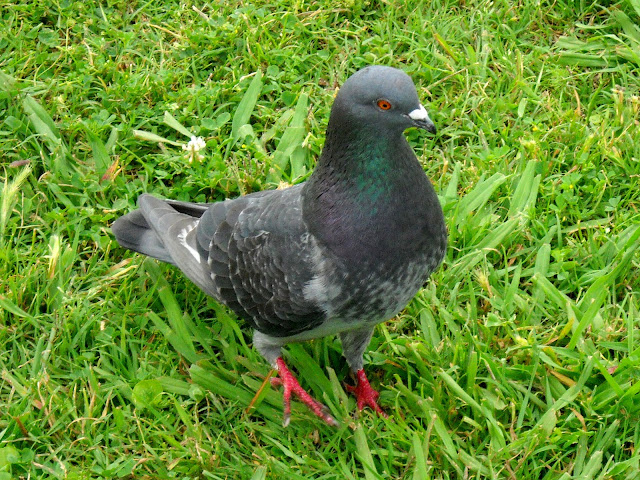Most cities
around the world have one thing in common: feral pigeons (Columba
livia), also known as rock doves. White Rock Lake in east Dallas
is no exception. The pigeon images below were all taken at Sunset Bay at White Rock
Lake.
Pigeons arrived in North
America with European settlers in the 17th-century. They were brought here as domestic
birds, caged and kept as a source of food.
A pigeon at White Rock Lake
Feral pigeons are derived from wild rock doves that were domesticated in the Middle East over 6,000 years ago. Rock doves were domesticated initially as a source of food, and for religious purposes. The terms "dove" and "pigeon" are interchangeable. Most people refer to smaller species as doves.
Pigeons are regular visitors to White Rock Lake, especially Sunset Bay.
Humans soon produced variants that could be used in other ways e.g. 3,000 years ago pigeons were being bred not only for the table, but for delivering messages and for racing. By the fifth century BC, Syria and Persia had widespread networks of message-carrying pigeons.
Feral pigeons are derived from wild rock doves
Pigeons are regular visitors to White Rock Lake, especially Sunset Bay. The image above was captured from the pier at Sunset Bay.
The average lifespan of a pigeon is 10 to 15 years. The oldest recorded pigeon was around 33 years.
Pigeongram
stamps are eagerly collected for their novelty value
We have all
heard of the international news service, Reuters. Guess how they started?
In 1850, Paul
Julius Reuter’s fledgling news service used homing pigeons to fly the 120km
between Aachen and Brussels, thereby laying the foundations for a global news
agency.
Pigeons
were also used to send messages from the Great Barrier Island in New Zealand (90
kilometers northeast of Auckland) to the mainland. It was referred to as a
pigeongram service. The pigeon post service began between the island and
Auckland in 1897, and ended when the first telegraph cable was laid between the
island and the mainland in 1908.
Feral pigeons sharing a meal with a red winged blackbird
whilst a squirrel looks on
whilst a squirrel looks on
We are all so
impressed by the speed, power and efficiency of the Internet. Now consider
this. As part of a PR stunt in South Africa, a pigeon carried a 4GB memory
stick 80 kilometers. During the time it took the pigeon to deliver the memory
stick, the country’s biggest Internet service provider only managed to transfer
just 4% of the data on the memory stick. That’s amazing!
The average lifespan of a pigeon is 10 to 15 years
Homing pigeons played a vital part
in both World Wars as military messengers. In World War I, pigeons
proved to be an extremely reliable way of sending messages. Over 100,000 pigeons were used in the
war with an incredible success rate of 95% of the messages being delivered.
Pigeons did such extraordinary and valuable work
during WW1 that the British government protected them by law: “Killing,
wounding or molesting homing pigeons is punishable under the Defense of the
Realm Regulations by Six Months Imprisonment or £100 Fine. The public are reminded
that homing pigeons are doing valuable work for the government, and are
requested to assist in the suppression of the shooting of these birds.”
During World War II, the United
Kingdom used about 250,000 homing pigeons. The American Signal Pigeon Corps consisted
of 3,150 soldiers and
54,000 birds. Some 90% of
the messages got to
their destination.
These avian
secret agents saved innumerable human lives as well. Of the 54 Dickin Medals (the
highest possible decoration for valor given to animals - the animal’s VC)
awarded in World War II, 32 went to pigeons!
But don’t think the use of pigeons as a means of communication is outdated. Even today, homing pigeons are used in remote areas. In fact, the Police Pigeon Service in Orissa, India, was retired only in 2002.
But don’t think the use of pigeons as a means of communication is outdated. Even today, homing pigeons are used in remote areas. In fact, the Police Pigeon Service in Orissa, India, was retired only in 2002.
A pair of pigeons on the pier at Sunset Bay, White Rock Lake
Some religious groups feed pigeons for cultural reasons. For example, Sikhs feed pigeons to honor the high priest and warrior, Guru Govind Singh. Some Sikhs also believe that when they are reincarnated they will never go hungry if they have fed pigeons in their previous life.
Christians believe that the pigeon is both a symbol of peace and of the Holy Spirit.
In the image below, the male pigeon is going through a courtship ritual in an attempt to woo the female in the foreground. Feral pigeons mate for life.
The male pigeon is going through a courtship ritual in an attempt
to woo the female
to woo the female
The next time you see feral pigeons, show them some respect. They are far from being a pest, and we have so much to thank them for. These beautiful creatures were a source of food for our ancestors, they kept us informed by delivering the latest news, and these brave birds helped us win both World Wars.
------------
Please LIKE us on Facebook





















































